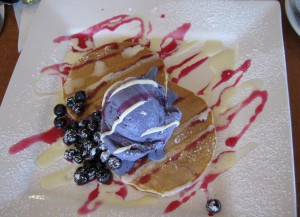Mouth-Watering
This mouth-watering dessert of lavender pancakes topped with lavender and honey icecream
with delicious local blueberries on the side, trickled with fresh cream and
raspberry sauce, lightly dusted with icing sugar, is not only a visual delight but a
gustatory rhapsody. Served in the restaurant at Bridestowe Lavender Farm in Tasmania,
Australia, with the perfume from seemingly endless rows of lavender flowers (Lavandula
Angustifola) wafting in from an open window makes this dish a quasi total sensual
experience. Just looking at this dish engenders saliva flow, and to taste it is ecstasy in the
mouth.
It is a far cry from Tasmania’s grisly convict past. While Australia’s indigenes have a
history in Australia of at least 40,000 years, European settlement of Tasmania only began
in 1803. The ensuing clash of cultures led to the brutal treatment of Aborigines by the
new settlers, virtually wiping out the entire indigenous population. Penal settlements
meted out severe punishment to European convicts sent over from Britain. Today
Tasmania has been transformed into a tourist destination, and its culinary delights and
stunning scenery, not to mention the abundance of fresh food from land and sea, cherries
to die for, and exotic flora and fauna provide food for thought as well as the palate.
Lynne Hume, University of Queensland


